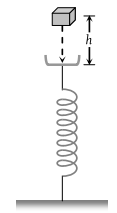A particle is acted upon by a force of constant magnitude which is always perpendicular to the velocity of the particle, the motion of the particle takes place in a plane. It follows that
(1) Its velocity is constant
(2) Its acceleration is constant
(3) Its kinetic energy is constant
(4) It moves in a straight line
Two bodies of masses 1 kg and 5 kg are dropped gently from the top of a tower. At a point 20 cm from the ground, both the bodies will have the same
(1) Momentum
(2) Kinetic energy
(3) Velocity
(4) Total energy
A cord is used to lower vertically a block of mass M by a distance d with constant downward acceleration . Work done by the cord on the block is
(1)
(2)
(3)
(4) Mgd
A particle moves in a straight line with retardation proportional to its displacement. Its loss of kinetic energy for any displacement x is proportional to-
(1) x2
(2) ex
(3) x
(4) loge x
The potential energy of a body is given by, U = A – Bx2 (Where x is the displacement). The magnitude of force acting on the particle is
(1) Constant
(2) Proportional to x
(3) Proportional to x2
(4) Inversely proportional to x
A 0.5 kg ball is thrown up with an initial speed 14 m/s and reaches a maximum height of 8.0m. How much energy is dissipated by air drag acting on the ball during the ascent
(1) 19.6 Joule
(2) 4.9 Joule
(3) 10 Joule
(4) 9.8 Joule
A block of mass m initially at rest is dropped from a height h on to a spring of force constant k. The maximum compression in the spring is x then-

(1)
(2)
(3)
(4)
1. \(7.46~\text{J}\)
2. \(7400~\text{J}\)
3. \(7.46~\text{ergs}\)
4. \(74.6~\text{J}\)
An engine pumps up 100 kg of water through a height of 10 m in 5 s. Given that the efficiency of the engine is 60% . If g = 10 ms–2, the power of the engine is
(1) 3.3 kW
(2) 0.33 kW
(3) 0.033 kW
(4) 33 kW
An engine pump is used to pump a liquid of density ρ continuously through a pipe of cross-sectional area A. If the speed of flow of the liquid in the pipe is v, then the rate at which kinetic energy is being imparted to the liquid is
(1)
(2)
(3)
(4)






